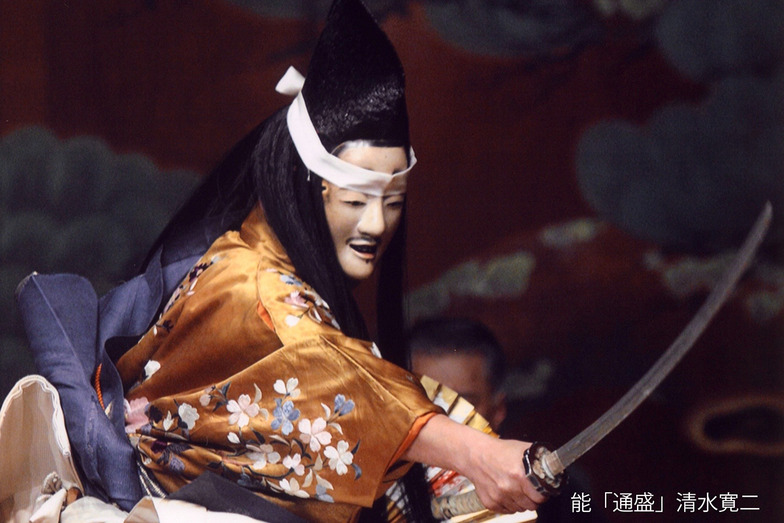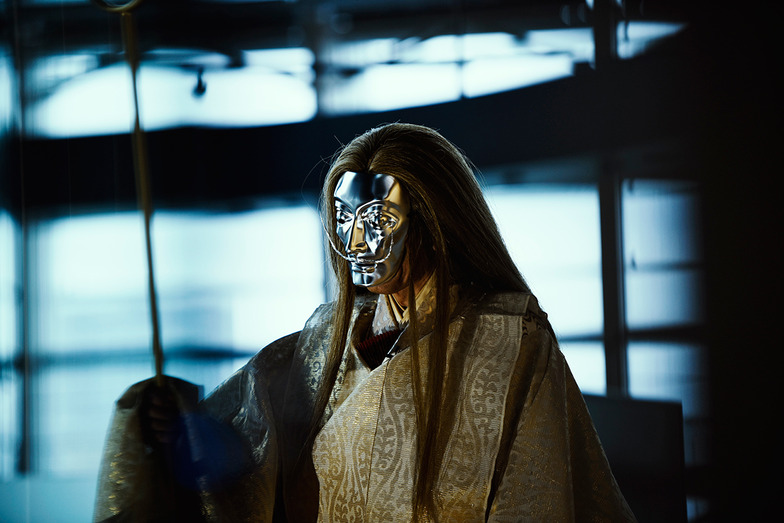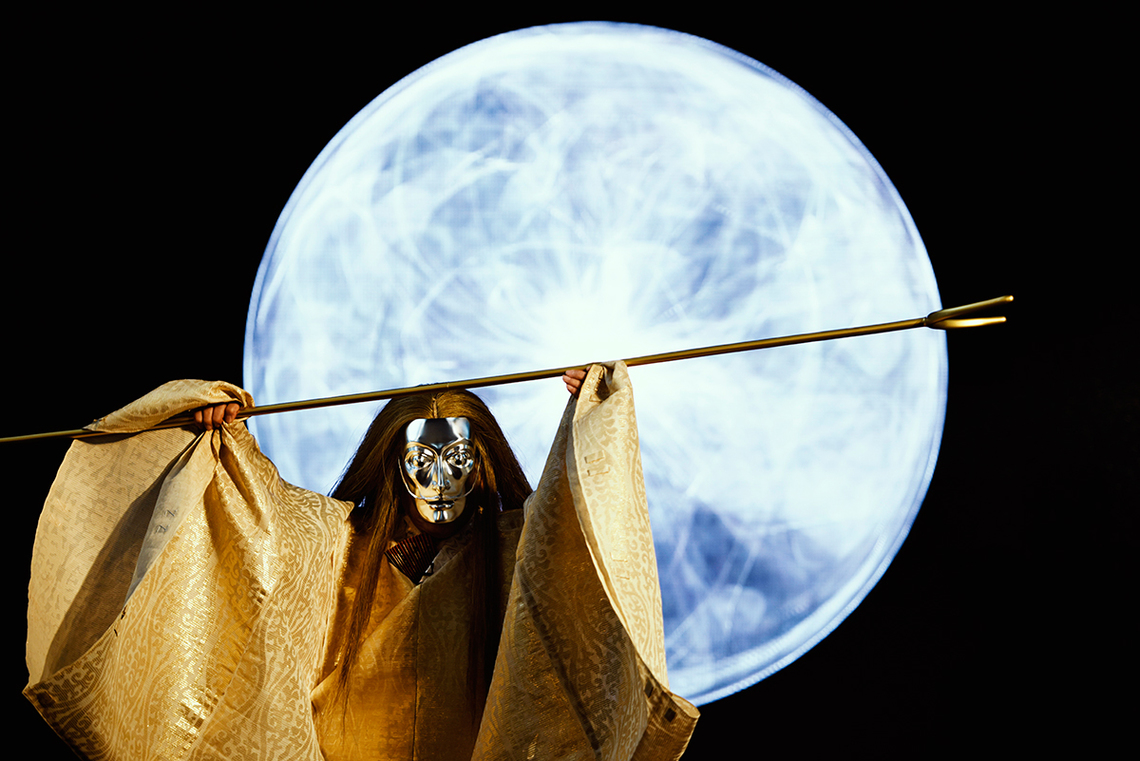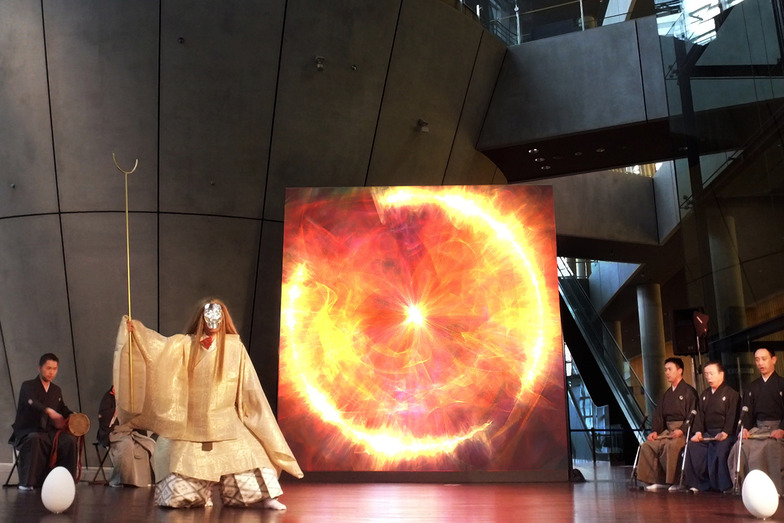Noh is the world's oldest surviving theatrical art form, continuing uninterrupted for over 650 years. It is a stage art highly regarded internationally for its profound expressive techniques. For Japanese people to "utilize" this valuable Noh in modern society, isn't it necessary to grasp its essential value and undertake efforts to apply it to the present day? The "Tech Noh Project" was launched aiming for this practice, and it was the catalyst for creating this "Dali Noh."
The Birth of Dali Noh
When launching the Teku Noh Project, Noh performer Kanji Shimizu and I (Shiro Murakami of Dentsu Inc.) discussed the potential for modern Noh staging and creating new Noh plays. We concluded that the "Mugen Noh" form—where a spiritual being becomes the protagonist, narrates its own "obsession," and performs a dance—offered significant possibilities for adaptation in the modern era.
Zeami of the Muromachi period created numerous Mugen Noh plays based on works like The Tale of the Heike and The Tales of Ise. We thus conceived the idea of creating new Mugen Noh plays in the modern era, using famous figures from the modern and contemporary periods as subjects.
Fortunately, we gained the opportunity to perform a new Noh play at the opening ceremony of the "Dali Exhibition." Thus, reviving Salvador Dali, the greatest eccentric genius of the 20th century, through a Mugen Noh play became the first performance project of the Teku Noh Project.
The creation of a new Noh play begins with composing the lyrics (the Noh lyrics). Since many dream-like Noh plays feature a character appearing with some kind of "obsession," I first read Dali's own writings and scholarly works to consider "Dali's obsession."
Dali, who had gained fame as a star of Surrealism before the war, was deeply shocked by the news of the atomic bombings in August 1945. His encounter with quantum mechanics then shifted his focus from the Freudian inner world to a deepening interest in cutting-edge science. From the 1950s onward, motifs symbolizing atomic nuclei frequently appeared in his work. In his final years, he created pieces inspired by advanced mathematical theories like topology and catastrophe theory.

〈The Transformation of Salvador Dalí's Art at the Dawn of the Atomic Age〉
Left: "Strange Things," c. 1935, featuring motifs characteristic of his Surrealist period
Center: *Melancholy Pastoral with Uranium and Atoms*, 1945, created in response to the shock of the atomic bombings of Japan
Right: *The Speed of the Virgin of Raphael*, c. 1954, based on his interest in advanced science including nuclear power
Collection of the Fundació Gala-Salvador Dalí, Figueres (Left) / Collection of the Museo Nacional Centro de Arte Reina Sofía, Madrid (Center, Right) © Salvador Dalí, Fundació Gala-Salvador Dalí, JASPAR, Japan, 2016.
*The Dalí exhibition is currently on view at The National Art Center, Tokyo until Monday, December 12, 2016.
Official Website
Such was Dalí's obsession—he did not live in modern society. The discovery of the Higgs boson in 2012, gravitational waves in 2016. He must be watching with envy from heaven as the mysteries of the universe are revealed one after another through scientific progress in our modern age. Or rather, knowing Dalí, he might already be creating works of art in heaven using this cutting-edge science. And together with his wife Gala, he has become an eternal being. It was from this thought that the following lyrics for the Noh play about Dalí were completed.
-----------------------------
《Dali Noh Lyrics》
Hey, I am Salvador Dalí
What is this Dali exhibition event
Is being held?
I'll hurry back from the land of the dead
To fear perfection
To fear perfection is foolish
Perfection is the divine principle
No one can reach it
Who sees God's elementary particle, the Higgs,
is immediately lost
From the waves of gravity
Appears from the waves of gravity
How beautiful it appears to me! The progress of science
Dali, yes, but Dali of the underworld
If he paints in the land of the dead
This must be the painting of the divine age
Oh, my beloved Gala
Come, let us be together forever
Gala, goddess who brings happiness
Let us dance down together once more
Praying for the success of the Dali exhibition
May thousands of guests come, a joyous occasion
May thousands of guests come, a joyous occasion
(Created by: Shiro Murakami / Supervised and set to verse by: Kanji Shimizu)
-----------------------------
In composing the lyrics, we drew inspiration from Dali's famous quote, "Have no fear of perfection - you'll never reach it," and excerpted portions from the lyrics of "Takasago," a renowned celebratory Noh play.
Learning from tradition, harnessing technology
Noh, which was a relatively simple performing art during the Muromachi period, evolved over time through the Azuchi-Momoyama and Edo periods. Costumes incorporated the cutting-edge technology of each era, and the acting became refined down to the smallest details. While Noh is often perceived today as something to "preserve," it can be imagined that it was actually built upon the accumulated creativity of each era.
To recreate the creative energy of that era, Dali Noh was produced by bringing together modern technology in its staging. We received cooperation from individuals possessing the highest level of contemporary technical skill and creativity: Ohmaki Seiki for the production of the Noh masks, and Rhizomatiks Architecture for the spatial video projections.

From wooden Noh masks

to metal Noh masks
In designing the new Dali Noh mask, we drew heavily from the forms of traditional Noh masks that evoke complex emotions in the viewer. Referencing various masks—male masks, divine spirit masks, demon masks—we created a mask design symbolizing the figure of Dali. This design was then "carved out" as a Noh mask through the astonishing technical skill of the engineers at Ohmaki Seiki, revealing its appearance as a new Noh mask.
A sharp contrast from the tranquil space of the Noh theater to the performance in the National Art Center Tokyo's expansive atrium. The "Hashikake" in Noh theaters symbolizes a bridge connecting to another world. This concept was adapted for the production, featuring the Noh performers descending from the second floor via elevator—a symbolic descent. Furthermore, otherworldly images projected onto large LED displays rapidly transformed the space, creating a stage with an overwhelming amount of information distinct from traditional Noh, delivering a powerful impact to the audience.
*Behind-the-scenes details are available in the making-of video.
Contemporary Technology "Hidden" in Collaboration with Traditional Performing Arts
"What is hidden is a flower; what is not hidden cannot be a flower. To know this distinction is the essence of the flower." This is a famous passage from the Fūshi Kadenshō. In this chapter, Zeami teaches the importance of preserving the secrets of the arts. In Dali Noh, we witnessed the "rare flower" born from the "secret art" unique to modern society.
That "secret art" is the profound, globally acclaimed technology possessed by Ohmaki Seiki and Rhizomatiks Architecture. By providing a glimpse of this technology and blending it with the world of Noh, we achieved "a means to stir feelings unexpected in the human heart—this is the flower."
This experience reaffirmed my belief in the limitless potential for co-creation between traditional performing arts like Noh and modern technology. For any traditional culture, if we discern its essential value and safeguard its core, we can find a path to co-creation. While this practice is extremely challenging, I intend to continue this endeavor, however modest my contribution, for the future of Japan's world-renowned culture.
(Shiro Murakami, Dentsu Inc.)
After Dali Noh
Everyone, what did you think of the Dali Noh video? I imagine you didn't feel much dissonance with the innovative performance of Tech Noh. This is because Dali himself, who began with a traditional style in his youth, was someone who constantly pursued innovation.
This Dali Noh received coverage across various media and earned praise from overseas guests, including the Dali Foundation in Spain. As the verse says, "A thousand guests, ten thousand visitors—how auspicious!" Dali Noh was also a prayer for the success of the Dali exhibition. I hear the weekend immediately after the opening ceremony was a huge success, with lines forming for about 40 minutes.
Launching this project has made me keenly aware of the potential of "Noh × Technology." Moving forward, I aim to collaborate with diverse creators and organizations to establish this as a central project for disseminating Japanese culture.
"Never forget your original aspiration" is a phrase from Zeami, who systematized Noh. He further stated, "Life is filled with many such original aspirations." We too intend to remember these many beginnings and strive for the multifaceted development of this project.
(Keita Yoneyama, Dentsu Inc.)







